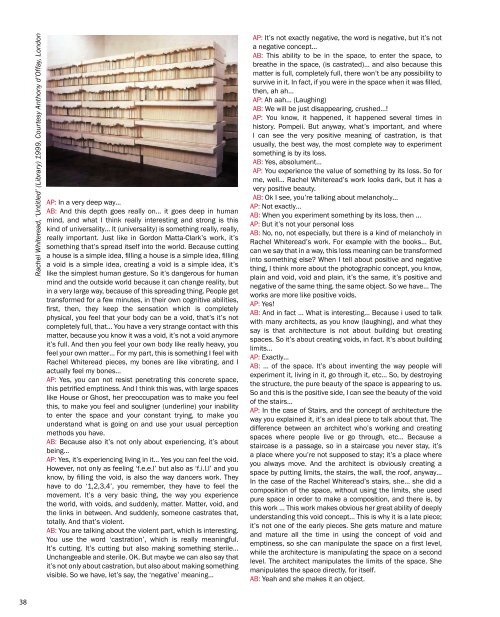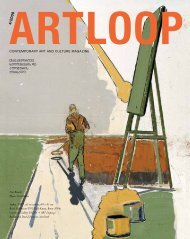xelovnebis saerTaSoriso Jurnali - Artisterium
xelovnebis saerTaSoriso Jurnali - Artisterium
xelovnebis saerTaSoriso Jurnali - Artisterium
Create successful ePaper yourself
Turn your PDF publications into a flip-book with our unique Google optimized e-Paper software.
8<br />
rachel Whiteread, ‘untitled’ (Library) 1999, Courtesy Anthony d’Offay, London<br />
AP: In a very deep way…<br />
AB: And this depth goes really on… it goes deep in human<br />
mind, and what I think really interesting and strong is this<br />
kind of universality… It (universality) is something really, really,<br />
really important. Just like in Gordon Matta-Clark’s work, it’s<br />
something that’s spread itself into the world. Because cutting<br />
a house is a simple idea, filling a house is a simple idea, filling<br />
a void is a simple idea, creating a void is a simple idea, it’s<br />
like the simplest human gesture. So it’s dangerous for human<br />
mind and the outside world because it can change reality, but<br />
in a very large way, because of this spreading thing. People get<br />
transformed for a few minutes, in their own cognitive abilities,<br />
first, then, they keep the sensation which is completely<br />
physical, you feel that your body can be a void, that’s it’s not<br />
completely full, that… You have a very strange contact with this<br />
matter, because you know it was a void, it’s not a void anymore<br />
it’s full. And then you feel your own body like really heavy, you<br />
feel your own matter… For my part, this is something I feel with<br />
Rachel Whiteread pieces, my bones are like vibrating, and I<br />
actually feel my bones…<br />
AP: Yes, you can not resist penetrating this concrete space,<br />
this petrified emptiness. And I think this was, with large spaces<br />
like House or Ghost, her preoccupation was to make you feel<br />
this, to make you feel and souligner (underline) your inability<br />
to enter the space and your constant trying, to make you<br />
understand what is going on and use your usual perception<br />
methods you have.<br />
AB: Because also it’s not only about experiencing, it’s about<br />
being…<br />
AP: Yes, it’s experiencing living in it… Yes you can feel the void.<br />
However, not only as feeling ‘f.e.e.l’ but also as ‘f.i.l.l’ and you<br />
know, by filling the void, is also the way dancers work. They<br />
have to do ‘1,2,3,4’, you remember, they have to feel the<br />
movement. It’s a very basic thing, the way you experience<br />
the world, with voids, and suddenly, matter. Matter, void, and<br />
the links in between. And suddenly, someone castrates that,<br />
totally. And that’s violent.<br />
AB: You are talking about the violent part, which is interesting.<br />
You use the word ‘castration’, which is really meaningful.<br />
It’s cutting. It’s cutting but also making something sterile…<br />
Unchangeable and sterile. OK. But maybe we can also say that<br />
it’s not only about castration, but also about making something<br />
visible. So we have, let’s say, the ‘negative’ meaning…<br />
AP: It’s not exactly negative, the word is negative, but it’s not<br />
a negative concept…<br />
AB: This ability to be in the space, to enter the space, to<br />
breathe in the space, (is castrated)… and also because this<br />
matter is full, completely full, there won’t be any possibility to<br />
survive in it. In fact, if you were in the space when it was filled,<br />
then, ah ah…<br />
AP: Ah aah… (Laughing)<br />
AB: We will be just disappearing, crushed…!<br />
AP: You know, it happened, it happened several times in<br />
history. Pompeii. But anyway, what’s important, and where<br />
I can see the very positive meaning of castration, is that<br />
usually, the best way, the most complete way to experiment<br />
something is by its loss.<br />
AB: Yes, absolument…<br />
AP: You experience the value of something by its loss. So for<br />
me, well… Rachel Whiteread’s work looks dark, but it has a<br />
very positive beauty.<br />
AB: Ok I see, you’re talking about melancholy…<br />
AP: Not exactly…<br />
AB: When you experiment something by its loss, then …<br />
AP: But it’s not your personal loss<br />
AB: No, no, not especially, but there is a kind of melancholy in<br />
Rachel Whiteread’s work. For example with the books… But,<br />
can we say that in a way, this loss meaning can be transformed<br />
into something else? When I tell about positive and negative<br />
thing, I think more about the photographic concept, you know,<br />
plain and void, void and plain, it’s the same, it’s positive and<br />
negative of the same thing, the same object. So we have… The<br />
works are more like positive voids.<br />
AP: Yes!<br />
AB: And in fact … What is interesting… Because i used to talk<br />
with many architects, as you know (laughing), and what they<br />
say is that architecture is not about building but creating<br />
spaces. So it’s about creating voids, in fact. It’s about building<br />
limits…<br />
AP: Exactly…<br />
AB: … of the space. It’s about inventing the way people will<br />
experiment it, living in it, go through it, etc… So, by destroying<br />
the structure, the pure beauty of the space is appearing to us.<br />
So and this is the positive side, I can see the beauty of the void<br />
of the stairs…<br />
AP: In the case of Stairs, and the concept of architecture the<br />
way you explained it, it’s an ideal piece to talk about that. The<br />
difference between an architect who’s working and creating<br />
spaces where people live or go through, etc… Because a<br />
staircase is a passage, so in a staircase you never stay, it’s<br />
a place where you’re not supposed to stay; it’s a place where<br />
you always move. And the architect is obviously creating a<br />
space by putting limits, the stairs, the wall, the roof, anyway…<br />
In the case of the Rachel Whiteread’s stairs, she… she did a<br />
composition of the space, without using the limits, she used<br />
pure space in order to make a composition, and there is, by<br />
this work … This work makes obvious her great ability of deeply<br />
understanding this void concept… This is why it is a late piece;<br />
it’s not one of the early pieces. She gets mature and mature<br />
and mature all the time in using the concept of void and<br />
emptiness, so she can manipulate the space on a first level,<br />
while the architecture is manipulating the space on a second<br />
level. The architect manipulates the limits of the space. She<br />
manipulates the space directly, for itself.<br />
AB: Yeah and she makes it an object.



